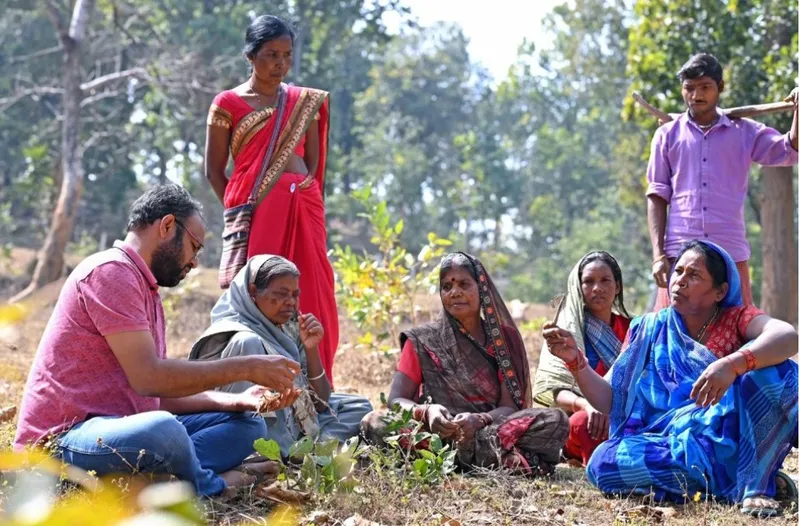Face of resistance: Inside Alok Shukla's fight to save Chhattisgarh’s forests
Alok Shukla spearheaded a successful community campaign that preserved 445,000 acres of biodiversity-rich forests from coal mining in Chhattisgarh.
Alok Shukla forged a deep relationship with the forest when he was just a child.
Born to farmer parents in Sagar, Madhya Pradesh, he has spent most of his adult life protecting the rights and livelihoods of the adivasis (tribals) living in Chhattisgarh and the biodiversity of the state.
Shukla is the convener of Chhattisgarh Bachao Andolan (Save Chhattisgarh Movement), an informal alliance of more than 20 grassroots movements across the state. He is also the founding member of the Hasdeo Aranya Bachao Sangharsh Samiti (Save Hasdeo Aranya Resistance Committee), a grassroots movement led by forest-dwelling villagers to resist unchecked industrialisation—particularly coal mining—in Hasdeo Aranya Forest in Chattisgarh.
For 12 years, Shukla led a campaign against coal mining in the Hasdeo Aranya Forest. In July 2022, his efforts bore fruit when the Chhattisgarh government adopted a resolution against mining in 445,000 acres of forest land, as well as cancelled the auction of the remaining 21 coal blocks.
“It is our enduring, peaceful demonstration for land, forest and water rights that led us to this breakthrough,” says Shukla.
In May this year, the 43-year-old was conferred the Goldman Environmental Prize—known popularly as the ‘Green Nobel’. Constituted by US philanthropists Rhoda and Richard Goldman in 1989, the award is dedicated to grassroots environmental activists.
A long-standing affinity for land
Shukla grew up with an intimate connection to the forests of Chhattisgarh but also witnessed how industrial invasion wrecked local livelihoods and the pristine biodiversity in the region.
In the early 2000s, when Chhattisgarh was newly carved out from Madhya Pradesh, Shukla saw that the state’s development model was built solely on the extraction of coal and minerals from these forests.
A 23.5 km stretch of river Shivnath (the longest tributary of the Mahanadi river) was sold to a private company called Radius Water Limited for industrial water supply.
In the wake of these developments, Shukla, who had just graduated with an MA in Political Science from Government Science College, Durg, joined the fight for ‘Jal, Jungle, Zameen, Izzat aur Adhikar’ (water-forest-land-respect-political rights) by the tribal communities to protect the dense, reserve forests that covered most coal blocks in the region.
“In the villages of Chhattisgarh, ponds and small water bodies are a significant part of everyday living. People often take a dip in them and children play around them,” says Shukla. “With increased industrial activity, we saw a layer of soot formed on these vital water bodies, cutting their use by villagers,” he adds.
In Raigarh, heavy metals and fly ash were causing respiratory problems and a spike in cancer cases among villagers, he recalls.
Lessons from Hasdeo
In 2012, his grassroots engagement led him to the forests of Hasdeo, where 23 coal blocks had been identified. These were covered by 60,000 hectares of forested land.
“I knew mining these forests would have far-reaching consequences, not just on villagers, but people living in the neighbouring cities as well,” Shukla notes, explaining that there was a threat of the disruption of water supply, which could drive elephants into villages. It also led to pollution of water bodies, affecting irrigation.

The Hasdeo Aranya forests are home to 15,000 Adivasis, many of who Alok Shukla united to resist industrialisation in the region.
The region is home to 15,000 adivasis, 25 endangered animal species, 92 bird species, and 167 rare medicinal plant species. It also has a wildlife corridor and two tiger reserves—Palamau and Kanha.
He also alleges that industrial projects were authorised using forged documents, without consulting gram sabhas, and in violation of Community Forest Management rights granted under Forest Rights Act, 2006.
“We decided to integrate all the stakeholders into our movement by spreading awareness,” he adds.
In 2013, Shukla brought more than 25 villages together to step up their resistance with Hasdeo Bachao Andolan, which over the years, garnered solidarity from Chattissgarh’s film community, social media users, artists, musicians, and the media.
“We continuously spoke, sang and engaged with all the stakeholders non-stop,” he adds.
In October 2021, close to 350 tribal villagers from Hasdeo set out on a 300-km-long march to Raipur to meet the Governor with the demand that their forests be protected.
“When people weren’t coming to us, we took the movement to them,” says Shukla. “Our peaceful, persistent and improvised ways to unite people from all walks of life to our cause created a groundswell of resistance.”
“I am certain this was the secret to our victory.”
Edited by Kanishk Singh







